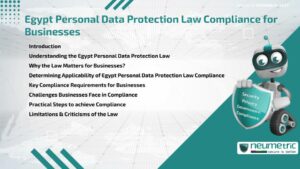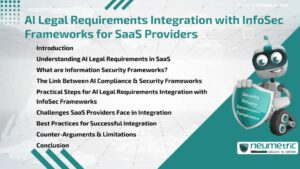Table of Contents
ToggleIntroduction to AI Vendor Risk under ISO 42001
Artificial Intelligence [AI] plays an increasing role in Business Operations. With this growth comes potential Risks associated with Third Party Vendors. ISO 42001 an emerging Standard for AI Management addresses these Risks. This Article explores AI Vendor Risk under ISO 42001 to help Teams understand & manage Vendor-related challenges effectively.
Purpose of Managing AI Vendor Risk
AI Vendor Risk under ISO 42001 focuses on ensuring that Organisations trust & verify their external AI Providers. This helps prevent issues like biased outcomes, Security lapses or Compliance failures. A structured approach reassures Stakeholders & Supports responsible AI use.
Explore the Standard basics at ISO website overview.
Framework Overview: ISO 42001 & Vendor Risk
ISO 42001 outlines processes for enforcing AI Policies, ensuring transparency & tracking Performance. Under this Standard, Vendor Risk Management becomes part of an overarching AI Governance Model. This ties AI Vendor Risk under ISO 42001 to strategy, ethics, documentation & ongoing oversight.
Types of AI Vendor Risks to Consider
AI Vendor Risk under ISO 42001 includes:
- Performance Risks like wrong Predictions
- Data Handling & Privacy concerns
- Model bias causing unfair decisions
- Vendor Lock‑in & Dependency
- Operational issues such as Downtime or Lack of support
These Risk types need mapping to Organisational controls & requirements.
How to Assess AI Vendor Risk under ISO 42001?
Start by listing AI Vendors & Scoring them on Risk attributes like Data Sensitivity, Decision Impact & Compliance obligations. Use Vendor Questionnaires tied to ISO 42001 Clauses. Then classify each Vendor’s Risk as low, medium or high & define review intervals accordingly.
Use Public Resources like NIST AI Risk Management Guide to support your approach.
Tools & Techniques for Risk Evaluation
Risk Matrices, Vendor Assessments & Control Checklists help operationalise AI Vendor Risk under ISO 42001. Internal Audits & Third Party reviews validate Vendor claims. Automated Monitoring Tools can track Vendor Performance & Flag issues early.
Refer to European AI Act overview for Compliance alignment ideas.
Limitations & Criticisms of the Framework
Some argue that AI Vendor Risk under ISO 42001 may be too generic, lacking Sector-specific checks. The Standard assumes Organisations have mature AI Governance already. Additionally, Vendors may lack transparency into their Models, making Assessments incomplete.
Balancing Risk Mitigation & Innovation
While managing AI Vendor Risk under ISO 42001, Organisations must avoid stifling innovation. Instead of blocking Vendors, teams can negotiate Controls such as Performance Metrics, Audit Rights or Vendor change notices to maintain agility.
Roles & Responsibilities in Risk Management
Effective oversight calls for clear Ownership. Legal Teams should review Contracts. Risk or Compliance Managers score Vendors. IT & Data Teams monitor Technical Performance. Executives oversee alignment with Organisational AI goals.
Takeaways
- AI Vendor Risk under ISO 42001 helps Organisations assess & monitor Third Party AI Risks
- The Framework links Risk to AI Governance & Performance Metrics
- Assessments should cover Bias, Security, Data & Dependency Risks
- Balance control with innovation by setting clear Guardrails
- Clear Roles & Evidence-based tracking boosts transparency & trust
FAQ
What does AI Vendor Risk under ISO 42001 cover?
It includes Bias, Data Privacy, Performance issues, Vendor Lock‑in & Operational Risks.
Do we need different Assessments for each Vendor?
Yes. Risk Levels vary based on Data Sensitivity, Vendor size & Process scope.
Can small Teams implement ISO 42001 Vendor Risk Guidelines?
Yes. They can use simplified Risk Matrices & Questionnaires to align Assessments.
How often should Vendor Risk be reviewed?
Review frequency should match Risk level, high-Risk Vendors may need Quarterly reviews.
Does ISO 42001 supersede other AI Regulations like the EU AI Act?
No. It complements other Regulations by offering a focus on Governance & Risk Processes.
References
- ISO Artificial Intelligence Standards
- NIST AI Risk Management Framework
- European Commission – AI Act
- OECD AI Principles
- IEEE Ethically Aligned Design
Need help?
Neumetric provides Organisations the necessary help to achieve their CyberSecurity, Compliance, Governance, Privacy, Certifications & Pentesting goals.
Organisations & Businesses, specifically those which provide SaaS & AI Solutions, usually need a CyberSecurity Partner for meeting & maintaining the ongoing Security & Privacy needs & requirements of their Clients & Customers.
SOC 2, ISO 27001, ISO 42001, NIST, HIPAA, HECVAT, EU GDPR are some of the Frameworks that are served by Fusion – a centralised, automated, AI-enabled SaaS Solution created & managed by Neumetric.
Reach out to us!





